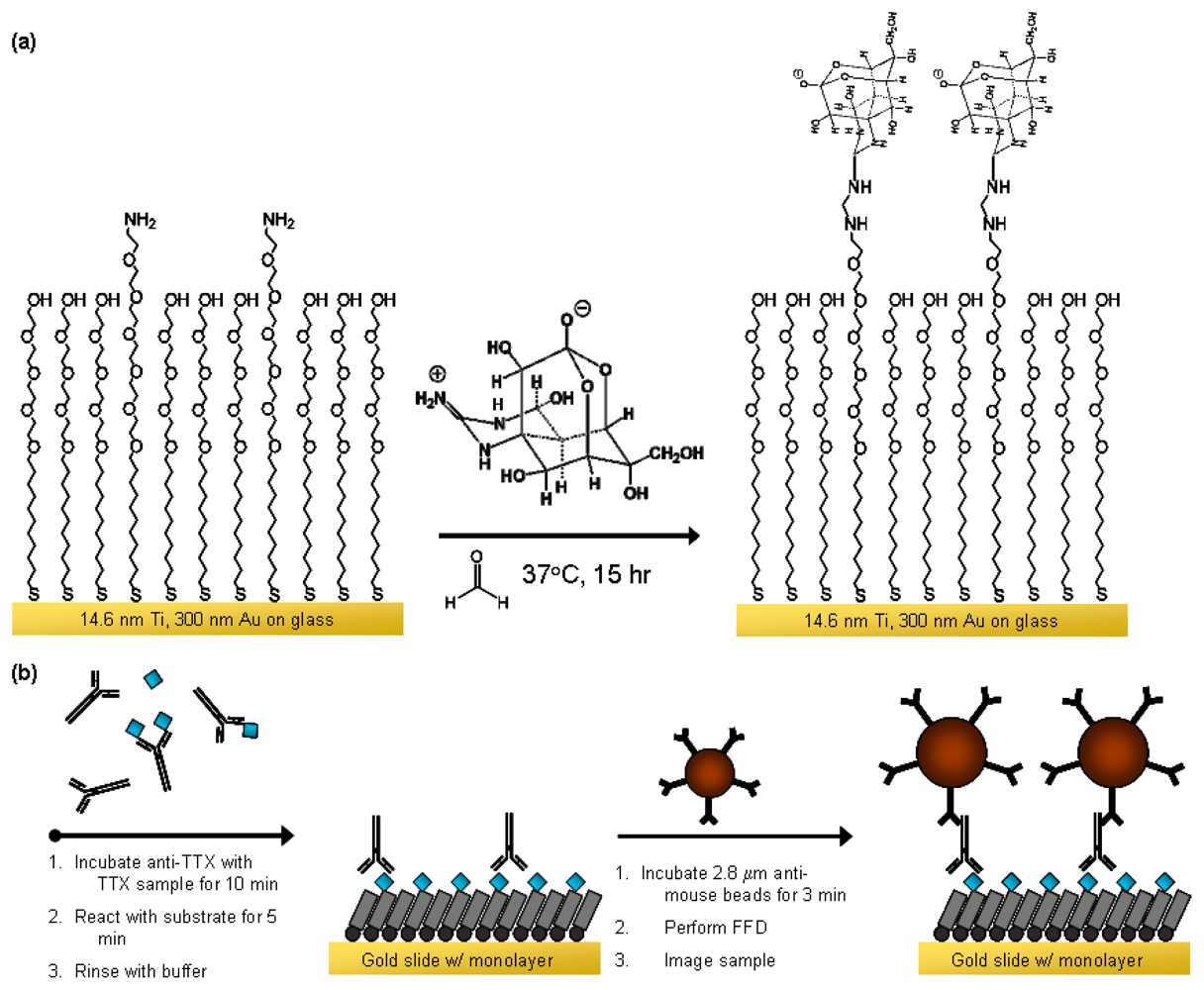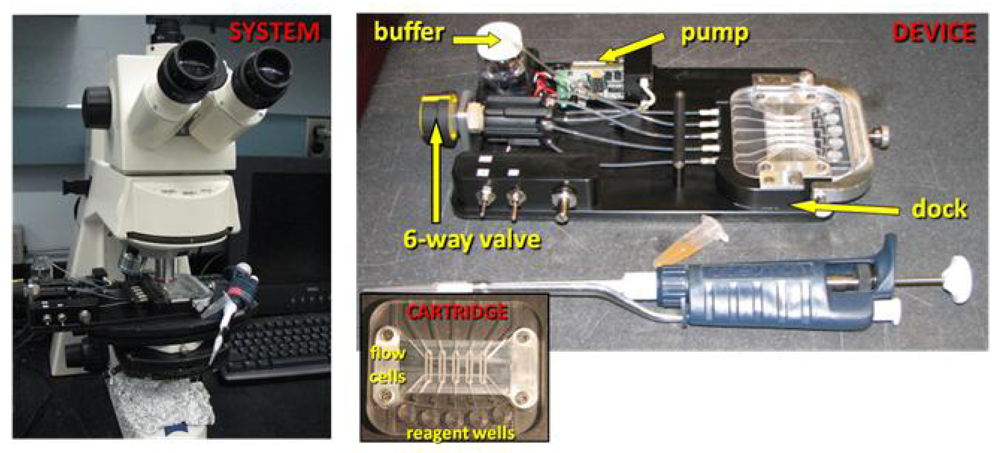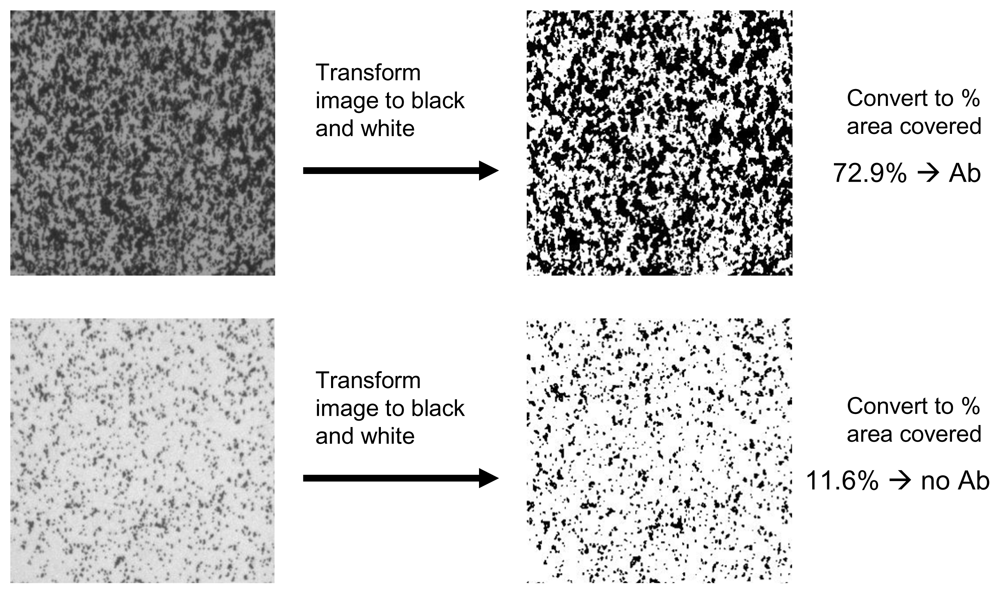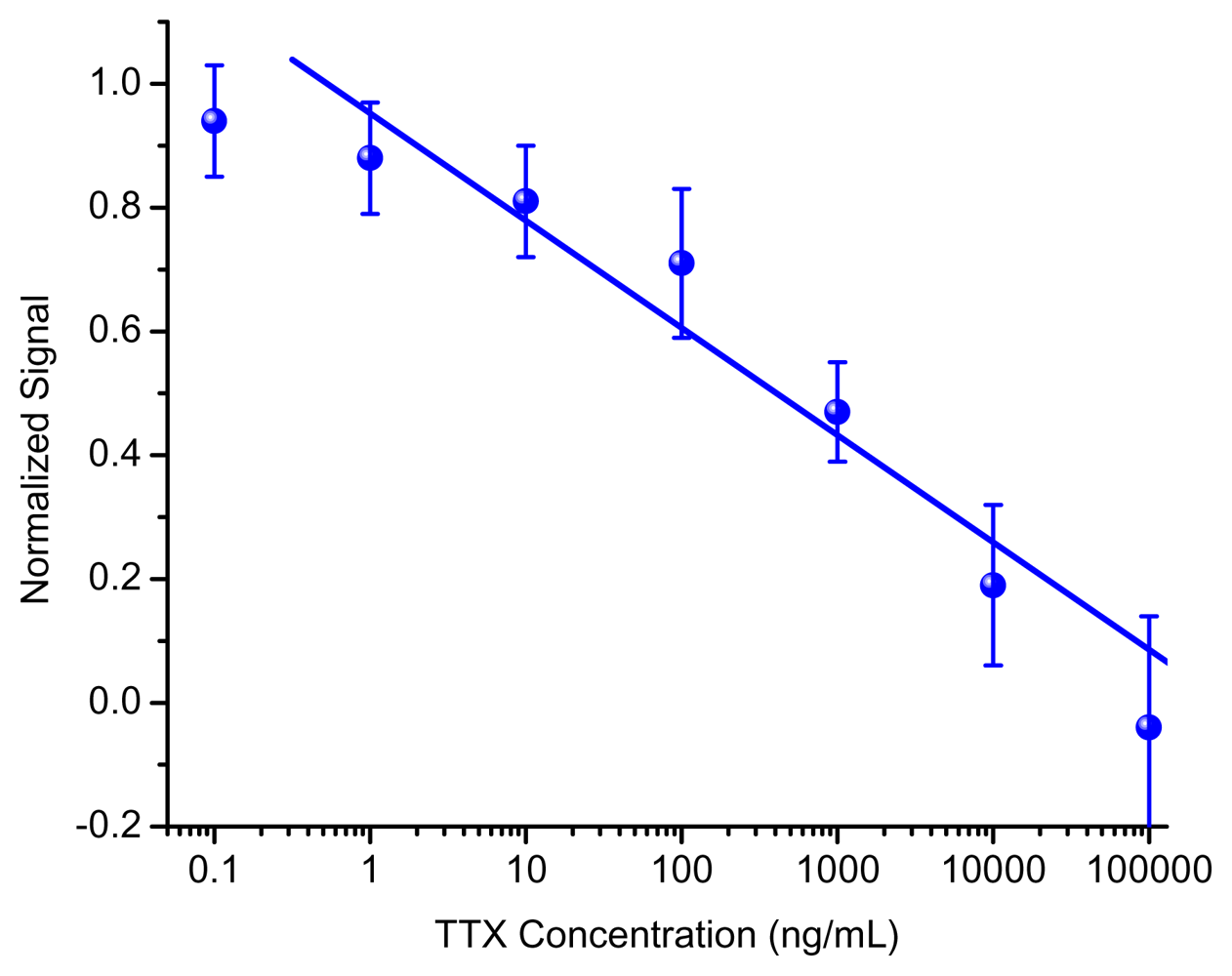Fluidic Force Discrimination Assays: A New Technology for Tetrodotoxin Detection
Abstract
:1. Introduction
2. Results and Discussion
2.1. Immunoassay Platform and FFD Instrumentation
2.2. TTX Immunoassay Results
3. Experimental Section
3.1. Materials
3.2. Substrate Preparation
3.3. FFD Setup
3.4. Inhibition Immunoassay
3.5. Data Processing
4. Conclusions
Acknowledgements
References
- US-FDA Bad Bug Book: Foodborne Pathogenic Microorganisms and Natural Toxins Handbook. Available online: http://www.fda.gov/Food/FoodSafety/FoodborneIllness/FoodborneIllnessFoodbornePathogensNaturalToxins/BadBugBook/default.htm Accessed on 11 December 2009.
- Kalaitzis, JA; Chau, R; Kohli, GS; Murray, SA; Neilan, BA. Biosynthesis of toxic naturally-occurring seafood contaminants. Toxicon 2009. [Google Scholar] [CrossRef]
- Noguchi, T; Arakawa, O; Takatani, T. TTX accumulation in pufferfish. Comp Biochem Physiol D: Genomics Proteomics 2006, 1, 145–152. [Google Scholar]
- Tamplin, ML. A bacterial source of tetrodotoxins and saxitoxins. ACS Symp Ser 1990, 418, 78–106. [Google Scholar]
- Miyazawa, K; Noguchi, T. Distribution and origin of tetrodotoxin. J Toxicol Toxin Rev 2001, 20, 11–33. [Google Scholar]
- Llewellyn, LE. Sodium channel inhibiting marine toxins. Prog Mol Subcell Biol 2009, 46, 67–97. [Google Scholar]
- Isbister, GK; Kiernan, MC. Neurotoxic marine posioning. Lancet Neurol 2005, 4, 219–228. [Google Scholar]
- Noguchi, T; Arakawa, O. Tetrodotoxin–Distribution and accumulation in aquatic organisms, and cases of human intoxication. Mar Drugs 2008, 6, 220–242. [Google Scholar]
- CDC. Tetrodotoxin poisoning associated with eating puffer fish transported from Japan--California, 1996. MMWR Morb. Mortal Wkly Rep 1996, 45, 389–391.
- Cohen, NJ; Deeds, JR; Wong, ES; Hanner, RH; Yancy, HF; White, KD; Thompson, TM; Wahl, M; Pham, TD; Guichard, FM; Huh, I; Austin, C; Dizikes, G; Gerber, SI. Public health response to puffer fish (Tetrodotoxin) poisoning from mislabeled product. J Food Prot 2009, 72, 810–817. [Google Scholar]
- Alcaraz, A; Whipple, RE; Gregg, HR; Andresen, BD; Grant, PM. Analysis of tetrodotoxin. Forensic Sci Int 1999, 99, 35–45. [Google Scholar]
- Hungerford, JM. Committee on natural toxins and food allergens-Marine and freshwater toxins. J AOAC Int 2006, 89, 248–269. [Google Scholar]
- Association of Official Analytical Chemists (AOAC), Paralytic shellfish poison: Biological method. Final action. Method 959.08. In Official Methods of Analysis, 15th ed; Helrich, K (Ed.) AOAC: Arlington, VA, USA, 1990; pp. 881–882.
- Doucette, GJ; Powell, CL; Do, EU; Byon, CY; Cleves, F; McClain, SG. Evaluation of 11-[H-3]-tetrodotoxin use in a heterologous receptor binding assay for PSP toxins. Toxicon 2000, 38, 1465–1474. [Google Scholar]
- Davio, SR; Fontelo, PA. A competitive displacement assay to detect saxitoxin and tetrodotoxin. Anal Biochem 1984, 141, 199–204. [Google Scholar]
- Powell, CL; Doucette, GJ. A receptor binding assay for paralytic shellfish poisoning toxins: Regent advances and applications. Nat Toxins 1999, 7, 393–400. [Google Scholar]
- Chen, C.-Y; Chou, H.-N. Detection of tetrodotoxin by high performance liquid chromatography in lined-moon shell and puffer fish. Acta Zool Taiwan 1998, 9, 41–48. [Google Scholar]
- Diener, M; Christian, B; Ahmed, MS; Luckas, B. Determination of tetrodotoxin and its analogs in the puffer fish Takifugu oblongus from Bangladesh by hydrophilic interaction chromatography and mass-spectrometric detection. Anal Bioanal Chem 2007, 389, 1997–2002. [Google Scholar]
- Shoji, Y; Yotsu-Yamashita, M; Miyazawa, T; Yasumoto, T. Electrospray ionization mass spectrometry of tetrodotoxin and its analogs: Liquid chromatography/mass spectrometry, tandem mass spectrometry, and liquid chromatography/tandem mass spectrometry. Anal Biochem 2001, 290, 10–17. [Google Scholar]
- Yasumoto, T; Michishita, T. Fluorometric Determination of tetrodotoxin by high performance liquid chromatography. Agric Biol Chem 1985, 49, 3077–3080. [Google Scholar]
- Deeds, JR; White, KD; Etheridge, SM; Landsberg, JH. Concentrations of saxitoxin and tetrodotoxin in three species of puffers from the Indian River Lagoon, Florida and the location for multiple cases of saxitoxin puffer poisoning from 2002 to 2004. Trans Am Fish Soc 2008, 137, 1317–1326. [Google Scholar]
- Neagu, D; Micheli, L; Palleschi, G. Study of a toxin-alkaline phosphatase conjugate for the development of an immunosensor for tetrodotoxin determination. Anal Bioanal Chem 2006, 385, 1068–1074. [Google Scholar]
- Raybould, TJG; Bignami, GS; Inouye, LK; Simpson, SB; Byrnes, JB; Grothaus, PG; Vann, DC. A monoclonal antibody-based immunoassay for detecting tetrodotoxin in biological samples. J Clin Lab Anal 1992, 6, 65–72. [Google Scholar]
- Zhou, Y; Li, Y.-S; Pan, F.-G; Liu, Z.-S; Wang, Z. The development and optimization of ELISA for the determination of tetrodotoxin. J Med Coll PLA 2007, 22, 347–351. [Google Scholar]
- Taylor, AD; Ladd, J; Etheridge, S; Deeds, J; Hall, S; Jiang, SY. Quantitative detection of tetrodotoxin (TTX) by a surface plasmon resonance (SPR) sensor. Sens Actuat B Chem 2008, 130, 120–128. [Google Scholar]
- Lin, WC; Jen, HC; Chen, CL; Hwang, DF; Chang, R; Hwang, JS; Chiang, HP. SERS study of tetrodotoxin (TTX) by using silver nanoparticle arrays. Plasmonics 2009, 4, 187–192. [Google Scholar]
- Kreuzer, MP; Pravda, M; O’Sullivan, CK; Guilbault, GG. Novel electrochemical immunosensors for seafood toxin analysis. Toxicon 2002, 40, 1267–1274. [Google Scholar]
- Mulvaney, SP; Myers, KM; Sheehan, PE; Whitman, LJ. Attomolar protein detection in complex sample matrices with semi-homogeneous fluidic force discrimination assays. Biosens Bioelectron 2009, 24, 1109–1115. [Google Scholar]
- Mulvaney, SP; Ibe, CN; Tamanaha, CR; Whitman, LJ. Direct detection of genomic DNA with fluidic force discrimination assays. Anal Biochem 2009, 392, 139–144. [Google Scholar]
- Mrksich, M; Whitesides, GM. Using self-assembled monolayers that present oligo(ethylene glycol) groups to control the interactions of proteins with surfaces. Poly(Ethylene Glycol)-Chemistry and Biological Applications 1997, 680, 361–373. [Google Scholar]
- Prime, KL; Whitesides, GM. Adsorption of proteins onto surfaces containing end-attached oligo(ethylene oxide)–a model system using self-assembled monolayers. J Am Chem Soc 1993, 115, 10714–10721. [Google Scholar]
- Hermanson, GT. Bioconjugate Techniques; Academic Press: San Diego, CA, USA, 1996; pp. 215–218. [Google Scholar]
- Mulvaney, SP; Cole, CL; Kniller, MD; Malito, M; Tamanaha, CR; Rife, JC; Stanton, MW; Whitman, LJ. Rapid, femtomolar bioassays in complex matrices combining microfluidics and magnetoelectronics. Biosens Bioelectron 2007, 23, 191–200. [Google Scholar]
- Andersson, K; Hamalainen, M; Malmqvist, M. Identification and optimization of regeneration conditions for affinity-based biosensor assays. A multivariate cocktail approach. Anal Chem 1999, 71, 2475–2481. [Google Scholar]
- Wang, H; Chen, SF; Li, LY; Jiang, SY. Improved method for the preparation of carboxylic acid and amine terminated self-assembled monolayers of alkanethiolates. Langmuir 2005, 21, 2633–2636. [Google Scholar]
- Tamanaha, CR; Malito, MP; Mulvaney, SP; Whitman, LJ. Reusable, compression-sealed fluid cells for surface mounting to planar substrates. Lab Chip 2009, 9, 1468–1471. [Google Scholar]




© 2010 by the authors; licensee Molecular Diversity Preservation International, Basel, Switzerland This article is an open-access article distributed under the terms and conditions of the Creative Commons Attribution license (http://creativecommons.org/licenses/by/3.0/).
Share and Cite
Yakes, B.J.; Etheridge, S.M.; Mulvaney, S.P.; Tamanaha, C.R. Fluidic Force Discrimination Assays: A New Technology for Tetrodotoxin Detection. Mar. Drugs 2010, 8, 565-576. https://doi.org/10.3390/md8030565
Yakes BJ, Etheridge SM, Mulvaney SP, Tamanaha CR. Fluidic Force Discrimination Assays: A New Technology for Tetrodotoxin Detection. Marine Drugs. 2010; 8(3):565-576. https://doi.org/10.3390/md8030565
Chicago/Turabian StyleYakes, Betsy Jean, Stacey M. Etheridge, Shawn P. Mulvaney, and Cy R. Tamanaha. 2010. "Fluidic Force Discrimination Assays: A New Technology for Tetrodotoxin Detection" Marine Drugs 8, no. 3: 565-576. https://doi.org/10.3390/md8030565




